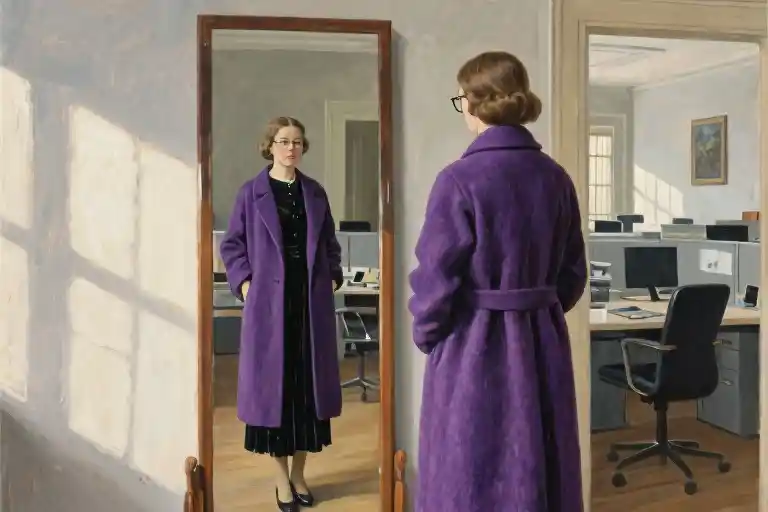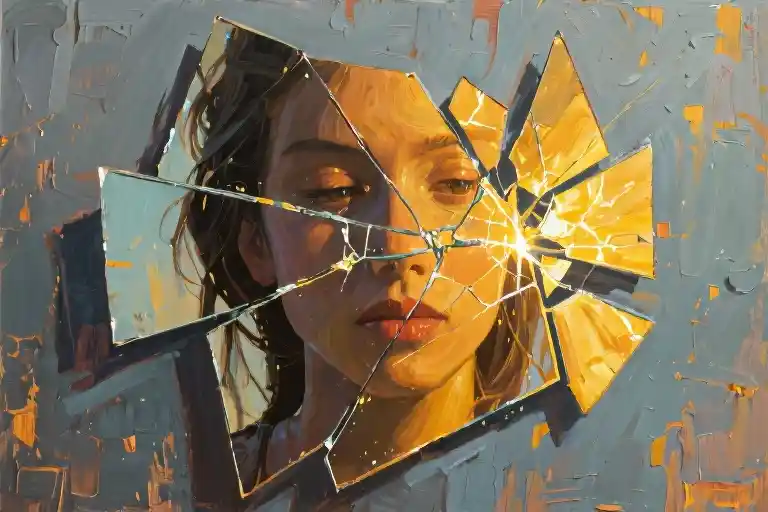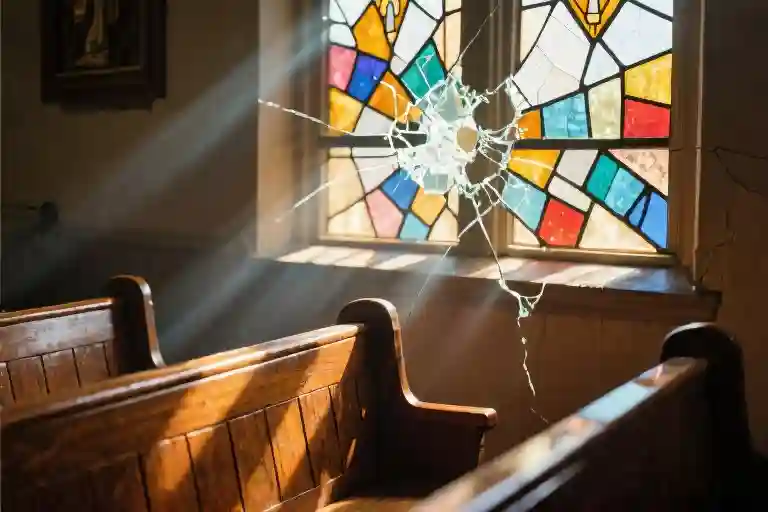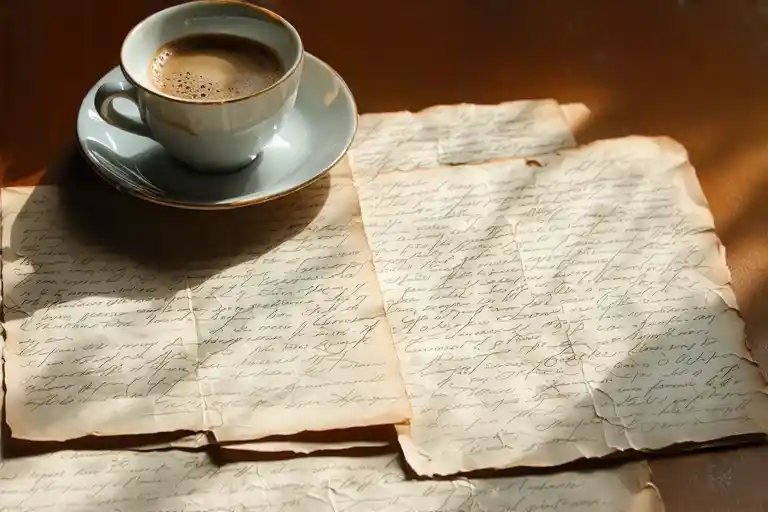The mirror in my office has become such a fixture that I rarely notice its presence anymore. It simply exists there, tall and wide, catching the afternoon light in a way that makes the whole wall seem alive. Most days, my reflection passes through it unnoticed—just another moving part in the machinery of my daily routine.
But today was different. Today, when I glanced to the right during a momentary pause between tasks, the woman looking back at me might as well have been a stranger. There she stood: black-framed glasses perched slightly askew, long dark hair falling over one shoulder, wrapped in that absurdly long purple wool coat I’d bought on a whim last winter. The coat that touches the floor when I walk, making me feel like some misplaced character from a period drama. Paired with the black velvet skirt and matching top, the whole ensemble created an effect that was…unexpected.
‘Who is this woman?’ The question formed before I could stop it. Not in the philosophical sense we sometimes ponder in idle moments, but with genuine confusion. The image reflected back to me resembled one of those many possible versions of myself I’d imagined over the years—but which one? And why did she look so foreign standing in my office, in my clothes, wearing my face?
There was something distinctly uncanny about her appearance. The purple coat seemed too dramatic for midday, the black velvet too formal for answering emails. Together, they created a silhouette that belonged more to a Dutch Golden Age portrait than to contemporary office life. I could practically see the heavy oil brushstrokes framing her—me?—in that careful, studied way painters capture their subjects. The kind of painting where the woman never quite meets your gaze, where the richness of her garments contrasts with something restrained in her expression.
What unsettled me most wasn’t the clothes themselves, but how naturally they seemed to fit this version of me. As if I’d accidentally dressed up as someone else and only just noticed. The realization carried a peculiar weight—like discovering you’ve been speaking in a foreign accent without meaning to. The reflection showed a woman who looked collected, intentional, perhaps even slightly intimidating in her vintage-inspired formality. A woman who might have stepped out of early feminist literature or those serious black-and-white photographs of suffragettes. A woman who didn’t quite match the person I feel myself to be most days.
And yet…there was something compelling about her. Something that made me stand a little straighter, adjust my glasses less nervously. Maybe that’s why we keep certain clothes in our closets—not because they suit our current lives, but because they hold echoes of people we might still become. The purple coat suddenly seemed less like a costume and more like an invitation.
The afternoon light shifted then, changing the quality of the reflection. For a moment, the mirror showed not a stranger, but simply me again—same slightly tired eyes, same familiar office background. But the question lingered: when we look in the mirror, who exactly are we expecting to see? And what happens when someone unexpected looks back?
The Time Capsule in My Closet
The purple wool coat hangs heavy on my shoulders, its weight carrying more than just fabric. Every time I run my fingers along its textured surface, I’m touching threads woven with history. This particular shade of violet – not quite royal, not quite lavender – whispers secrets of suffragettes who stitched their demands into banner cloth. The wool scratches at my wrists with the same insistence as those early 20th century voices demanding to be heard.
Velvet skirts weren’t meant for typing at modern desks. The black fabric pooling around my ankles belongs in a Vermeer painting, where women sat frozen in domestic scenes, their stiff collars framing silent faces. My office chair creaks beneath this anachronism, the sound disrupting what should be a museum-quality stillness. The contrast makes me smile – here I am, a walking contradiction between centuries.
Fashion historians would have a field day with this outfit. The 1910s saw women literally cutting their constraints, shearing off corsets while still clinging to certain formalities. My ensemble mirrors that transitional moment – the severe lines nodding to propriety, the unconventional color shouting rebellion. Dressing becomes archaeology when every morning I excavate layers of meaning from my closet.
What fascinates me most isn’t the clothing itself, but why I’m drawn to these particular textures and hues. The wool smells faintly of mothballs and grandmothers’ attics, yet it makes me feel oddly contemporary. Perhaps because true modernity means having the freedom to curate our identities from across timelines. My purple coat isn’t a costume – it’s a carefully selected piece in an ongoing conversation between past selves and present possibilities.
The mirror reflects more than fabric; it shows the tension between preservation and progress. That black velvet skirt has outlasted empires, surviving as both oppression and empowerment depending on who wears it. My fingers leave temporary marks on its nap, soon to be brushed away – just like each generation leaves faint impressions on these enduring materials before making room for new interpretations.
The Double Self in the Frame
The mirror in my office doesn’t just reflect light—it reflects centuries. When I catch my own gaze, I see not just a woman in a purple coat, but the ghostly afterimages of all the women who’ve stood before mirrors since Vermeer’s time. There’s something unsettling about how closely my reflection resembles those Dutch Golden Age portraits, where women exist in perfect stillness, their velvet dresses whispering against chair legs that never move.
This mirror-frame relationship reveals more than I anticipated. The same compositional tricks that made 17th century paintings feel alive—the slight off-center positioning, the play of shadow across the cheekbone, the way my black-framed glasses catch the light like pearl earrings—all conspire to turn my reflection into art. But whose art? And whose idea of a woman?
That ‘half-oppressed’ quality Thomas and Turner might call ‘the tension of classic prose’ manifests physically here. My posture straightens unconsciously, chin tilting to that exact angle seen in Rembrandt’s portraits. The weight of the wool coat suddenly feels less like fabric and more like the accumulated expectations of generations. Zinsser was right about clutter—we carry invisible layers of cultural baggage in every fold of our clothing.
What fascinates me most is how contemporary this ancient dynamic remains. The ‘mirror stage’ Lacan described plays out daily in smartphone screens and department store fitting rooms. We still perform for unseen audiences, still arrange our faces into acceptable compositions. My purple coat might as well be a modern version of those starched lace collars—another uniform, another frame.
Yet there’s power in recognizing the frame. Fish’s observation about sentences applies equally to self-perception: ‘The structure is always there before the content arrives.’ Seeing myself as both subject and object, both painter and portrait, creates space to question which parts feel authentically mine versus culturally inherited. That black velvet skirt doesn’t just brush against my legs—it brushes against history.
Perhaps this is what Pinker meant about style revealing thought. The way we clothe and compose ourselves speaks volumes about the narratives we’ve absorbed. Right now, my reflection tells a story of crossed cultures—Nordic reserve woven through Mediterranean warmth, contemporary independence constrained by historical echoes. The mirror won’t resolve these tensions, but it makes them visible. And visibility, as any woman in a Vermeer painting could attest, is the first step toward agency.
The Geography of a Face
The woman in the mirror carried a certain chill in her posture, a sharpness in the cheekbones that didn’t match the soft curves of Lisbon’s cobblestone streets. My reflection seemed borrowed from some northern latitude – that pale complexion better suited to diffused Scandinavian light than Portugal’s golden sun. The black-framed glasses added an almost clinical detachment, like a librarian from a Bergman film rather than the expressive warmth expected of Mediterranean women.
Portuguese femininity traditionally thrived on contrasts: dark hair against sun-warmed skin, full skirts swirling at festa dances, voices that could carry across vineyards. Our beauty standards favored women who looked like they’d stepped from a José de Almada Negreiros painting – all bold colors and dynamic angles. Yet here I stood wrapped in Nordic austerity, my purple coat swallowing the very silhouette that should have swayed with southern rhythm.
This cultural mismatch went deeper than aesthetics. Northern European women in art history often appeared contained – think of Vermeer’s subjects frozen in domestic moments, their emotions guarded behind starched collars. Portuguese portraits showed women leaning from balconies, hands gesturing mid-conversation, skirts capturing movement. My mirror image had somehow absorbed that northern restraint, the very opposite of our cultural script where women’s voices fill kitchen gatherings and public squares alike.
Globalization makes curious collages of our identities. The same internet that taught me to appreciate Danish interior design also delivered endless images of Scandinavian minimalism as the pinnacle of sophistication. Magazine racks overflowed with features on ‘French girl beauty’ while Portuguese women remained invisible unless framed as exotic others. Small wonder my subconscious had pieced together an ideal from these fragments – a cosmopolitan chimera wearing its dislocation like a badge of honor.
Yet the body resists such geographical impositions. My skin still tanned despite careful avoidance of sunlight, my hips refused to conform to the androgynous silhouettes in northern fashion magazines. The mirror became a battleground where competing cultural expectations played out – the effortless elegance of Paris, the functional beauty of Berlin, all layered over a Lisbon foundation that kept peeking through like old fresco beneath whitewash.
Perhaps this explains the uncanny valley sensation when confronting that reflection. The woman in purple wasn’t false exactly, but neither was she complete. She represented one possible permutation among many – the version shaped by too many hours scrolling through design blogs from Copenhagen, by art house films that equated emotional reserve with depth. A self assembled from cultural exports and algorithmic suggestions rather than rooted experience.
We rarely consider how geography shapes our self-image until confronted with its contradictions. That day, the mirror didn’t just show my face – it revealed the invisible borders I’d internalized, the unspoken hierarchies that made northern restraint read as sophisticated while southern expressiveness seemed quaint. The most subversive act might be reclaiming the right to be inconsistently, gloriously local in a world that prizes rootless cosmopolitanism.
The Fading Coat’s Revelation
The purple wool coat no longer holds the same depth of color it once did. Where the fabric catches the afternoon light streaming through my office window, the threads reveal a subtle fading – like old frescoes where time has gently erased the artist’s original intent. I run my fingers along the sleeve’s edge, feeling how the once-prickly wool has softened with wear, much like how my initial shock at the mirror’s reflection has dulled into quiet contemplation.
This coat that once seemed to costume me in someone else’s identity now feels more like a second skin. The way it pools around my ankles when seated creates the same folds I noticed in that Vermeer painting I saw last summer – the one where the woman’s blue dress spills across the tiled floor like liquid. Yet unlike the frozen moment in the Dutch masterpiece, my coat moves with me, collecting coffee stains and subway lint, documenting my actual life rather than an idealized portrait.
What fascinates me now isn’t how the mirror reflects an unfamiliar woman, but how clothing becomes a palimpsest of our evolving selves. The purple dye fading at the elbows marks where I lean against my desk; the slight pilling at the cuffs shows how often I push up my sleeves when working. These unintentional modifications make the garment truly mine, distancing it from whatever historical or artistic references I initially projected onto it.
Perhaps this is what adulthood means – not achieving some perfect, frozen ideal of ourselves, but accumulating the honest marks of living. The coat’s transformation mirrors my own gradual acceptance that identity isn’t about matching some internal or external template, but about becoming legible to oneself through time’s gentle abrasions.
I invite you to examine your own wardrobe artifacts. That sweater you’ve had for years, those shoes molded to your feet – how have they changed along with you? What stories do their alterations tell that no mirror could ever reflect? Share them with me, these tactile diaries of your becoming.
The Fading Coat and the Mirror’s Gaze
The purple wool coat catches the late afternoon light differently now. Where it once held the deep richness of violets in shadow, the fabric has taken on a muted, almost translucent quality as the sun slants through my office window. I watch as the threads seem to dissolve at the edges, the color bleeding into the golden light like watercolor on damp paper. This coat that once made me feel armored now feels like a second skin wearing thin.
Mirrors are strange collaborators in our lives. This tall, silent witness beside my desk has become less a reflector of surfaces and more a temporal device – folding moments together until past, present and possible futures occupy the same silvered plane. When I catch my reflection now, I see not just the woman in fading purple, but all the other versions that might have been. The mirror holds them all simultaneously: the stern Dutch matron from my earlier imaginings, the warm Lisbon baker my grandmother hoped I’d become, the sharp-suited businesswoman from my brief corporate phase. Their layered presence makes the glass seem thicker somehow.
There’s comfort in realizing how temporary these costumes prove to be. The coat that once defined me so completely is quietly returning to its component threads, just as the mirror slowly peels away my certainty about any fixed identity. What remains is the question that floats on the glass surface each morning, condensed like breath on a cold mirror: who will look back today?
Perhaps this is the gift of middle age – understanding that identity isn’t found in the mirror’s answer, but in continuing to ask the question. The purple will fade, the wool will fray, but the curiosity can remain bright. Tomorrow’s reflection might startle me again, might show someone I don’t recognize. And isn’t that possibility – that capacity for reinvention – more interesting than any single, static image?
When you look in your mirror tomorrow morning, which unexpected version of yourself might peer back? What old costumes are you ready to let fade, and what new possibilities might take their place? The glass never tells the whole truth, but it always tells an interesting one.





